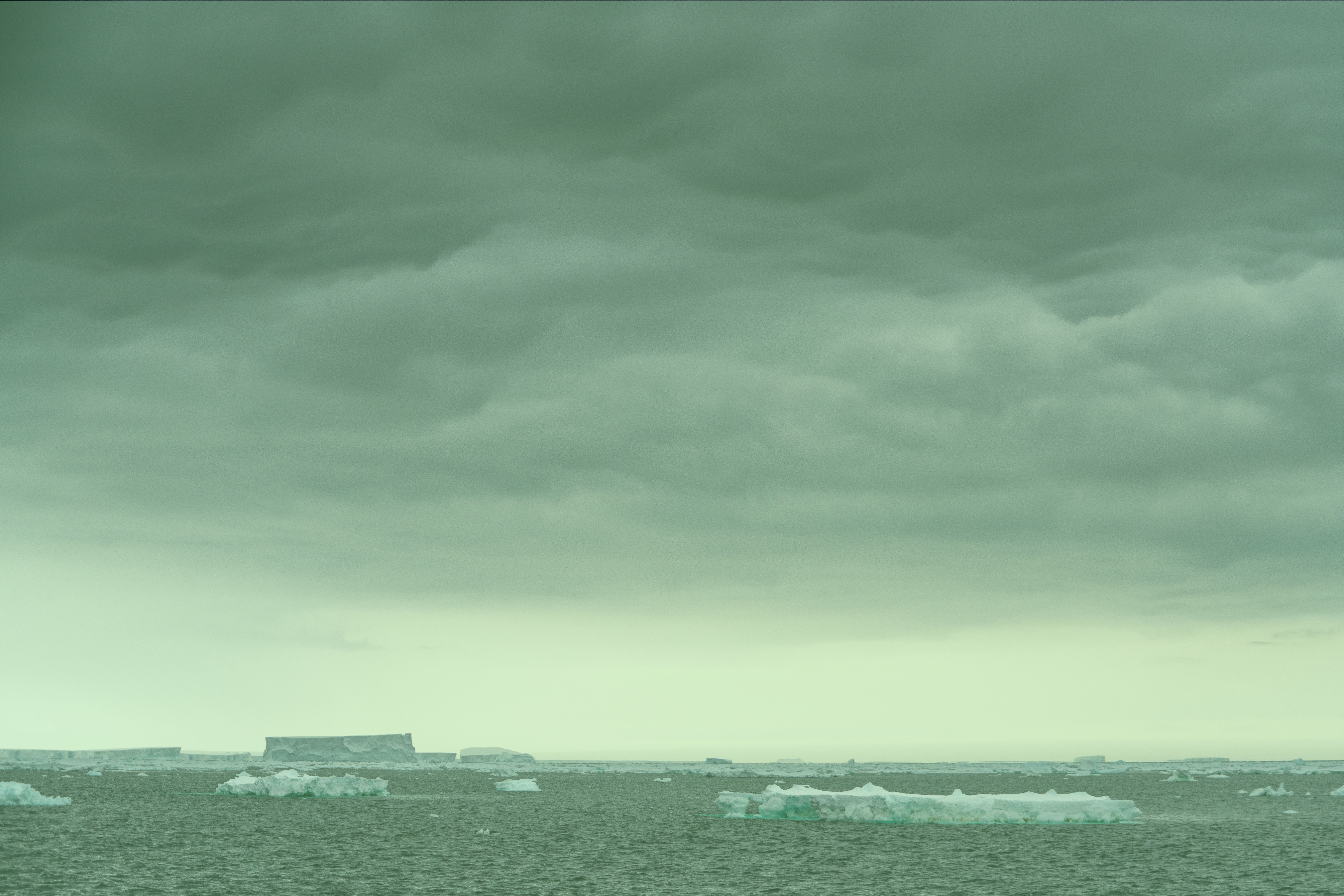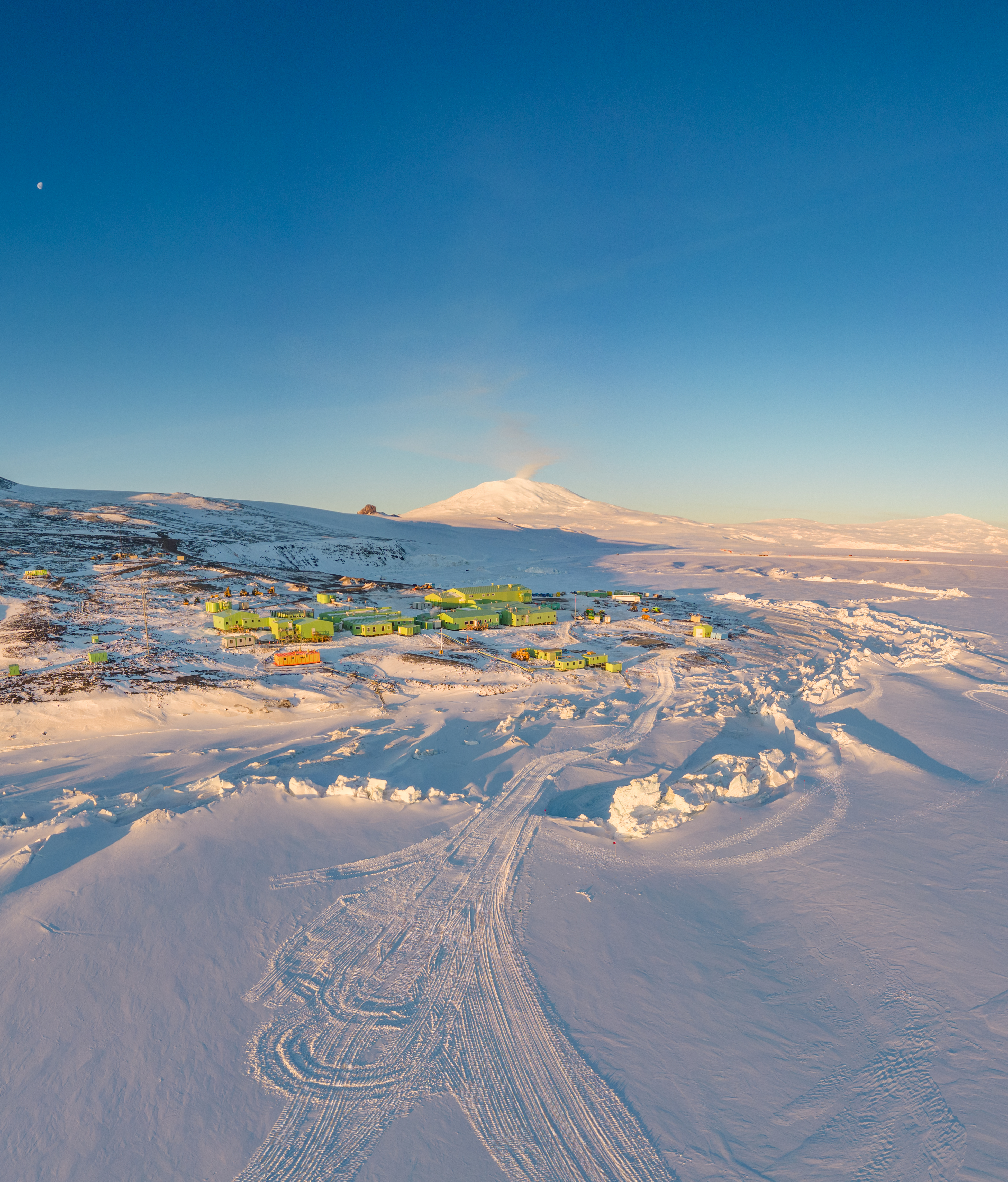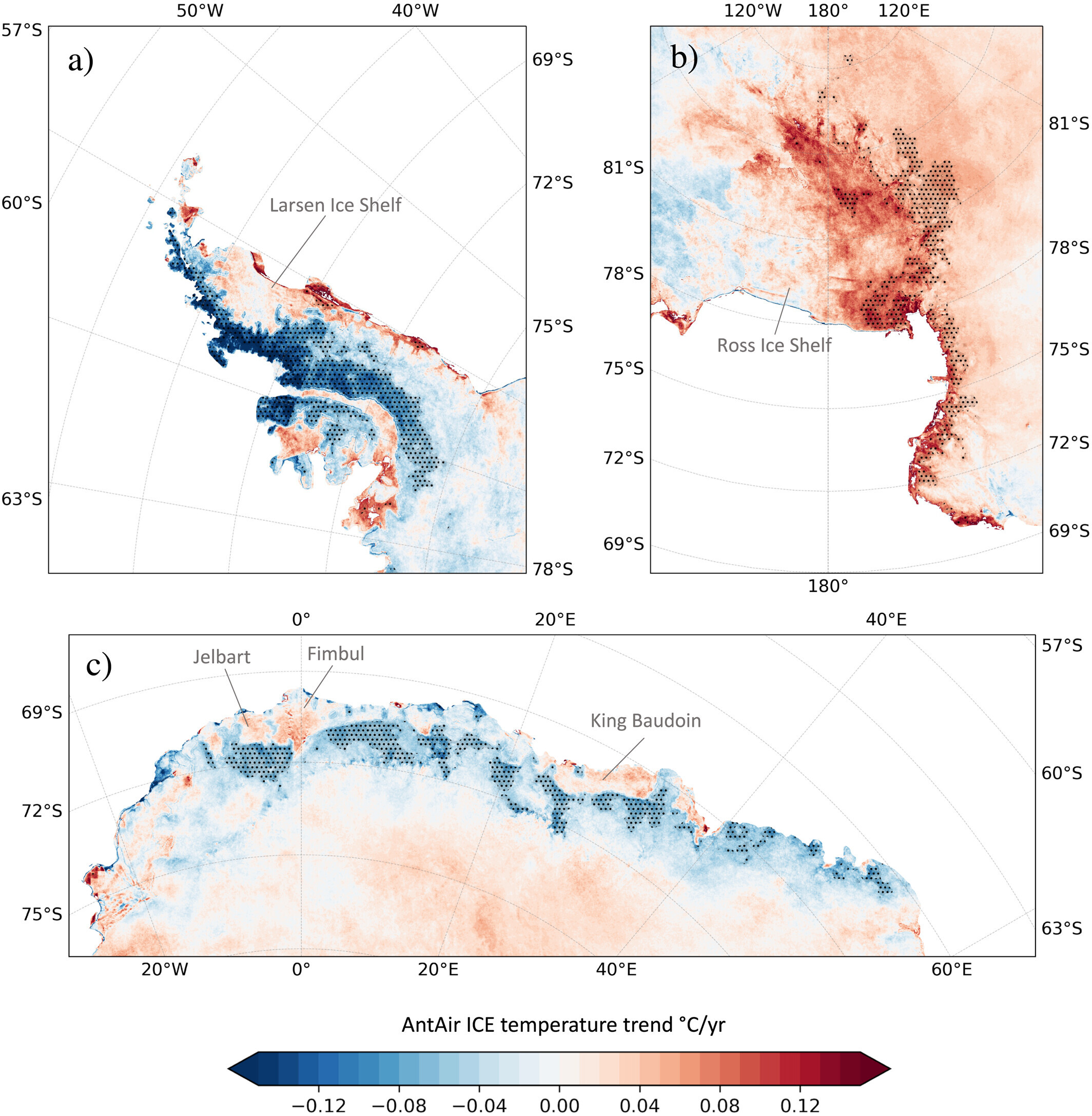
Antarctica's changing weather and climate
Local weather and climate variations impact Antarctica’s biodiversity, ice shelf stability, polynya dynamics (open water within sea ice), and hydrological systems. Antarctica's climate is an inextricable part of the complex global processes that drive dynamics in the atmosphere, hydrosphere (water) and cryosphere (ice). Changes in Antarctica are propagated around the globe, with far-reaching effects on weather, sea-level rise, and ocean circulation, for example. A clearer understanding of how global climate change translates to local conditions in Antarctica, particularly the frequency and intensity of extreme events, helps to improve our understanding of the consequences of change.
This summary
This summary aims to inform policy makers and scientific peers about research into weather and climate conducted in the Ross Sea region by New Zealand’s Antarctic Science Platform (ASP).
This research synthesis:
- shares fundamental information about weather and climate in Antarctica
- highlights climate-change related risks to weather across the Ross Sea region
- provides insights into weather processes that influence ice melt and accumulation
- provides examples of ASP contributions to the refinement of global weather and climate models to understand past, present, and future conditions in Antarctica and the Southern Ocean.
Key points
- Localised Antarctic weather data is crucial because it reveals finer-scale details about climate variability and its impacts, which are often masked by broader regional averages.
- The development and application of the AntAir ICE dataset has enabled ASP researchers to create high resolution, accurate surface temperature reconstruction models across Antarctica. Significant warming trends were detected in parts of the Ross Sea region during 2003–2021.
- West Antarctica's extreme air temperature events are linked to offshore high-pressure systems that cause the horizontal transport of warm moist air onto the continent. Extreme warming events in East Antarctica are associated with inland high-pressure systems and katabatic winds (strong, cold winds that flow down from the high interior ice sheet towards the coast).
- Precipitation dynamics tell us that the moisture sources of snowfall in Victoria Land are in the Southern Ocean, as well as local sources in the Ross Sea during summer, when sea ice is reduced.
- Foehn winds are emerging as an important driver of small-scale climate dynamics. Detection and identification of Foehn wind events with high-resolution, satellite-derived air temperature products has shown how, when localised Foehn winds occur, they can raise temperatures by as much as 40°C in just a few hours.
Antarctica is changing
Climate change impacts have emerged in recent years in Antarctica. Examples include:
- the catastrophic collapse of ice shelves in the Antarctic Peninsula and West Antarctica
- the record decline in Antarctic sea ice
- breeding failure of Emperor penguins.
More recently, we’ve witnessed the surprising appearance of extreme weather events in Antarctica. In March 2022, large parts of East Antarctica experienced a record-breaking heatwave with temperatures soaring 39°C above normal. While this heatwave lasted only a few days, the event was connected to:
- the collapse of the Conger Ice Shelf (the first ice shelf in East Antarctica to fail)
- changes in sea-ice condition
- changes in ocean circulation.
A growing network of ocean monitoring stations detected no less than 19 ocean heatwaves. Research teams observed waterfalls gushing off ice shelves, and documented the occurrence of rainbows, which evidence liquid water droplets in the air.
As global temperatures rise, regional and local patterns in Antarctica must be understood to effectively monitor change. Much of our work has focused on downscaling from regional patterns to local processes to help better understand the impacts of changing climate.

Photo: Anthony Powell
Automated weather station network has advanced
The ASP supports a network of automated weather stations — 18 in the McMurdo Dry Valleys and 2 in Northern Victoria Land — that collect data to better understand local conditions. Paired stations on valley floors and nearby ridges allow researchers to see how local wind patterns affect local temperatures. Local data is critical for downscaling satellite data, modelling simulations, and climate projections to make them more accurate for small areas and relevant to Antarctic ecosystems and glacier melt.
Weather station data have helped the ASP team to create a detailed map of near-surface air temperature across Antarctica from 2003 to 2021, down to 1 square kilometre resolution. To build the AntAir ICE model, the team combined real-world temperature data (from 117 weather stations across the continent) with satellite estimates (from MODIS) to train and validate the temperature model. The results were close to those from the widely used ERA5 climate model, but AntAir ICE offers higher spatial resolution. This makes it better for studying small-scale patterns and trends over time.
Antarctic warming trends over the past two decades
Using the AntAir ICE dataset, ASP researchers identified air temperature trends and extreme events across Antarctica between 2003–2021. Analysis confirmed a spatial variation across the continent, with a significant cooling over the Antarctic Peninsula and significant warming in the Ross Sea region, especially near coastal Victoria Land and the Transantarctic Mountains.
Different processes drove warming events across the continent. West Antarctica experienced localised extreme temperatures due to the transport of warm, moist air from further north. East Antarctica showed widespread warming driven by a large inland high-pressure system. Northward air flow (katabatic winds) from the interior toward the coastline manifested as additional warmth due to air being heated as it compressed down the elevation gradient.
Another key discovery was the impact of Foehn winds on surface temperature in the McMurdo Dry Valleys, especially in winter. When regional winds are light, cold air can settle in the valleys, causing temperatures to drop below -50°C. But when Foehn winds occur, they push warm air down into the valleys, raising temperatures by as much as 40°C in just a few hours. These warm wind events are becoming more frequent in winter, which explains the slow rise in annual temperatures in the Dry Valleys.

Annual mean temperature trend from AntAIR ICE for a) Antarctic Peninsula and b) Ross Sea region from 2003-2023. Dots mark a significant trend (p<0.05). (Source: Nielsen et al, 2025)
Weather and climate research
Our research is an important part of global understanding
Our work contributes to the growing understanding of Antarctic weather and climate, its spatial and temporal variability, regional drivers and long-term trends. Products such as AntAIR ICE provide an updatable, high-resolution picture of near-surface air temperature. This adds to our understanding of ice melt across the continent, and we know that surface melting and floating ice shelves can be a catalyst for ice sheets to rapidly disintegrate.
Our results show that locally-specific information on changes to ice melt and wetness must inform spatial planning and management measures. This information is vital to mitigate climate change effects on Antarctic environments and ecosystems.
Our work on downscaling regional climate projections is designed to address the need for managers to tailor specific management interventions. These interventions are to protect values, as documented in the Climate Change Response Work Programme of the Committee for Environmental Protection, which is part of the Antarctic Treaty System.
Contact information
James Renwick
Professor, Te Herenga Waka—Victoria University of Wellington
james.renwick@vuw.ac.nz
Marwan Katurji
Associate Professor, University of Canterbury
marwan.katurji@canterbury.ac.nz
Adrian McDonald
Atmospheric Physicist, University of Canterbury
adrian.mcdonald@canterbury.ac.nz
Definitions
Weather: The conditions in the air above the earth, such as wind, rain, or temperature, especially at a particular time over a particular area.
Climate: Long-term patterns and averages of weather conditions — such as temperature, humidity, wind, and precipitation — in a particular region over extended periods, typically 30 years.
Synoptic drivers: Large-scale weather patterns and atmospheric conditions that influence local weather events. These drivers can include atmospheric rivers, blocking events, and variations in the jet stream, all of which can transport moisture and affect precipitation patterns.
Southern Annular Mode (SAM): A climate pattern that describes the north-south movement of the westerly wind belt that circles Antarctica, influencing weather and climate across the Southern Hemisphere, including Aotearoa New Zealand.
Foehn winds: Warm, dry, and gusty winds that occur on the leeward (downwind) side of mountain ranges. They are a result of moist air being forced to rise over the mountains, where it cools and releases precipitation. As the air descends the other side, it is compressed and warms, resulting in the characteristic warm and dry conditions of a foehn wind.
Katabatic winds: Strong, cold winds that flow down from the high interior ice sheet towards the coast, due to gravity. They are caused by the cooling of air over the elevated ice sheet, creating dense, cold air that flows downhill under its own weight.
Polynya: An area of open ocean water that persists within sea ice, either due to wind-driven ice movement or upwelling of warmer water that prevents ice formation.
El Nino Southern Oscillation (ENSO): A climate pattern involving periodic changes in sea surface temperatures and atmospheric pressure in the central and eastern Equatorial Pacific Ocean.
Amundsen Sea Low (ASL): A climatological low-pressure center in the Amundsen Sea that plays a key role in influencing the weather and climate of West Antarctica and the surrounding Southern Ocean, including the Ross Sea region. ASL affects wind patterns, sea-ice distribution, and the flow of warm ocean water toward Antarctic ice shelves.
References
Burada GK, McDonald A, Renwick J, Jolly B (2023). Delineating polynya area using active and passive microwave sensors for the Western Ross Sea sector of Antarctica. Remote Sens. 15(10): 2545. https://doi.org/10.3390/rs1510...
Burada GK (2024). Observing, detecting and downscaling the winter coastal polynya characteristics over the Ross Sea sector of Antarctica. Thesis, Te Herenga Waka—Victoria University of Wellington. https://doi.org/10.26686/wgtn....
Cassano JJ, Nigro MA, Seefeldt MW, Katurji M, Guinn K, Williams G, DuVivier A (2021). Antarctic atmospheric boundary layer observations with the Small Unmanned Meteorological Observer (SUMO). Earth System Science Data 13: 969–982. https://doi.org/10.5194/essd-1...
Datta R, Katurji M, Nielsen E, Meyer H, Zawar‑Reza P, Valdes ML (2024). The winter Foehn footprint across McMurdo Dry Valleys of Antarctica using a satellite‑derived data set‑AntAir v1.0. Journal of Geophysical Research: Atmospheres 129(23). https://doi.org/10.1029/2023JD...
Hofsteenge MG, Cullen NJ, Conway JP, Reijmer CH, Van Den Broeke MR, Katurji M (2024). Meteorological drivers of melt at two nearby glaciers in the McMurdo Dry Valleys of Antarctica. Journal of Glaciology 70: e48. https://doi.org/10.1017/jog.20...
Hofsteenge MG, Cullen NJ, Sodemann H, Katurji M (2025). Synoptic drivers and moisture sources of snowfall in coastal Victoria Land, Antarctica. Journal of Geophysical Research: Atmospheres 130. https://doi.org/10.1029/2024JD...
Nielsen EB, Katurji M, Zawar-Reza P, Meyer H (2023). Antarctic daily mesoscale air temperature dataset derived from MODIS land and ice surface temperature. Scientific Data 10: 833. https://doi.org/10.1038/s41597‑023‑02720‑z
Nielsen EB, Katurji M, Zawar-Reza P, Cullen N (2025). Air temperature trends and extreme warming events across regions of Antarctica for the period 2003–2021. Journal of Geophysical Research: Atmospheres 130(9). https://doi.org/10.1029/2024JD...
Pletzer T, Conway JP, Cullen NJ, Eidhammer T, Katurji M (2024). The application and modification of WRF‑Hydro/Glacier to a cold‑based Antarctic glacier. Hydrology and Earth System Sciences 28(3). https://doi.org/10.5194/hess-2...